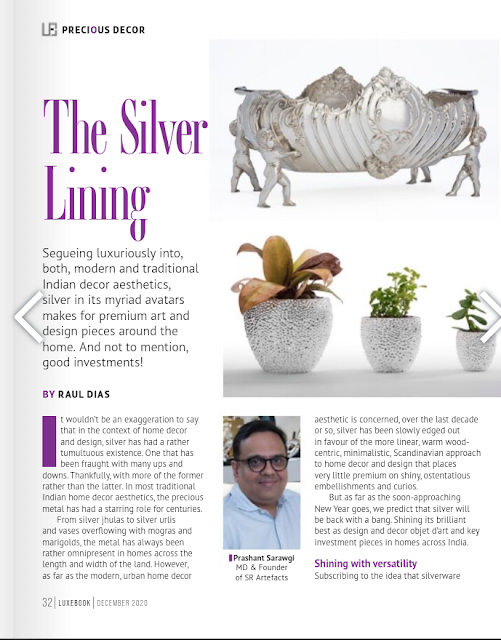Segueing luxuriously into both modern and traditional Indian decor aesthetics, silver in its myriad avatars makes for premium art and design pieces around the home. And not to mention, good investments!
By Raul Dias
It wouldn't be an exaggeration to say that in the context of home decor and design, silver has had a rather tumultuous existence. One that has been fraught with many ups and downs. Thankfully, with more of the former rather than the latter. In most traditional Indian home decor aesthetics, the precious metal has had a starring role for centuries.
From silver jhulas to silver urlis and vases overflowing with mogras and marigolds, the metal has always been rather omnipresent in homes across the length and width of the land. However, as far as the modern, urban home decor aesthetic is concerned, over the last decade or so, silver has been slowly edged out in favour of the more linear, warm wood-centric, minimalistic, Scandinavian approach to home decor and design that places very little premium on shiny, ostentatious embellishments and curios.
But as far as the soon-approaching New Year goes, we predict that silver will be back with a bang. Shining its brilliant best as design and decor objet d'art and key investment pieces in homes across India!
Shining with versatility
Subscribing to the idea that silverware can fit into any type of home decor, be it modern or traditional is silver expert Prashant Sarawgi who is also the Founder and Managing Director of SR Artefacts, a company that specialises in sliver home decor articles and collectables. “Traditionally, silverware has been used to decorate homes of royalty and was considered to be a status symbol. Detailed nakashi and meenakari work add great value to the very colourful aesthetic of Indian decor. Since time immemorial, Europe and Latin America have been making silver articles for home decor. Candle stands and tureen bowls for example, work wonderfully in a home with western decor aesthetics,” believes Prashant.
Weighing in on this is Vandana Sarawgi, Brand Partner of silverware brand Episode Silver. “For a typical Indian home, one could use more thematic design and pieces like silver idols, carved boxes and bowls to complete the look. For western home decor, contemporary pieces crafted in modern designs and finishes like mirrors, photo frames, laminates and candle stands could work wonderfully,” advices Vandana.
Giving us another perspective, by decorating one’s home with silver jewellery is silver jewellery and home decor designer Sangeeta Boochra, who hails from a family of Indian silversmiths who have been in the business since the mid-1800s. “There are multiple ways to decorate one's home with jewellery pieces. Vintage necklaces and bracelets can be framed in wood, while silver earrings on a wooden palette and these then placed on a feature wall make for great statement pieces. A silver hand harness or a maangtika can directly be framed on a marble slab or an onyx cut stone and placed as a decorative piece. The possibilities are endless,” says Sangeeta.
Making the bank!
Coming to the investment potential of silver, we see that the sky is truly the limit. A quick market analysis shows us that silver as a precious metal has increased 65% in last five months. No other metal has shown this sort of phenomenal rise. And in the past as well if we see the records, silver has always outperformed all other metals. Echoing this is Prashant who says that silver art piece keep appreciating in time. “Not just equivalent to their intrinsic silver value but also as they are not so easily found and manufactured any more. Therefore, of course silver art pieces work as great investment.”
Comparing silver home decor pieces to similar porcelain, ceramic or glass pieces, Vandana feels that they are definitely a far better investment. “Not only will the value of silver appreciate with time, it is also not as delicate and breakable as other materials used for home decor. Silver being a precious metal not only adds a luxurious and distinctive element, but is something that has an heirloom value,” says Vandana.
According to Sangeeta, silver even outperforms gold. “There are so many characteristics to the metal which no other metal has. Articles can be handcrafted in silver as it is a very soft metal, which is not possible in any other metal other than gold,” says Sangeeta. “For instance, anything made in silver is half the weight as compared to gold, as gold is heavier in weight when compared to silver. So let’s say an article in silver weighs 50 grams, the same piece in gold would come out to be 100 grams. So this gives an advantage to silver over gold as well.”
So, will 2021 be the Renaissance year that heralds the return of silverware art and decor pieces in our homes? Well, we’re surely hedging our bets on that and so should you!
Three tips for decorating with silver from our three experts
• Silver laminates are the latest trend in home decor and are used extensively to clad furniture and even walls.
• An all-time favourite as a grand silver idol at the entrance may be one of Lord Ganesha.
• A silver chowky, traditionally used only in marriages, is one of the most useful items that one can own. It can be used as a foot stool in front of a lounging chair, as a magazine stand, or even as a planter base.
(An edited version of this piece was first published in the December 2020 issue of LuxeBook magazine https://www.luxebook.in/)










